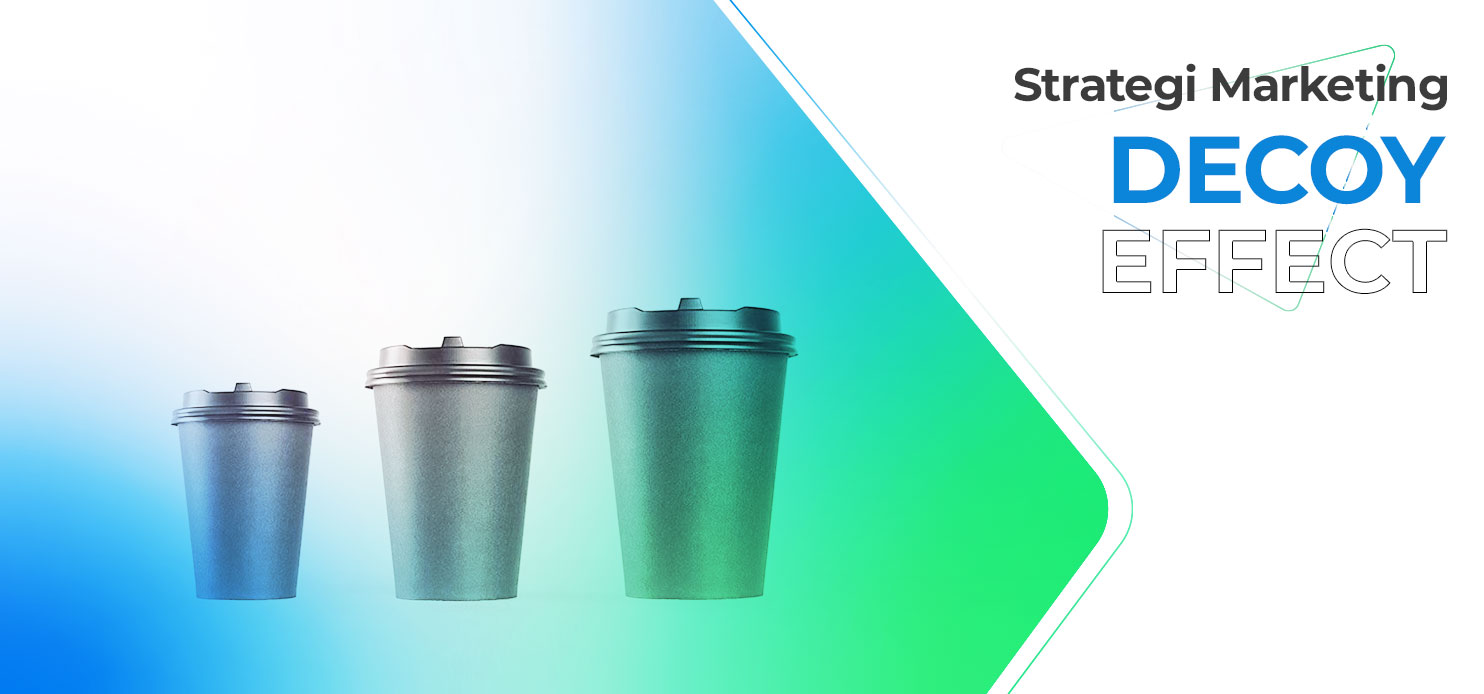Mengenal Strategi Marketing Decoy Effect yang Menguntungkan

Decoy Effect merupakan sebuah trik psikologi harga saat seorang konsumen cenderung mengganti pilihan di antara dua opsi saat diberikan opsi ketiga yang tidak seimbang. Pilihan- pilihan ini membuat satu harga menjadi tidak masuk akal sehingga kisaran harga lainnya terlihat sangat menguntungkan.
Pilihan yang diberikan akan relatif mendominasi secara asimetris. Ini juga disebut sebagai attraction effect atau asymmetric dominance effect. Dominasi asimetris yang dimaksud mengacu pada pancingan harga yang membuat salah satu opsi lain jauh lebih menarik.
Faktor yang mendominasi itu dapat dirasakan dari segi kuantitas, kualitas, fitur tambahan, dan sebagainya. Harga produk yang ditentukan sebagai decoy memang tidak dimaksudkan untuk dijual. Nilai tersebut diberikan hanya untuk mendorong konsumen menjauh dari harga pesaing menuju target yaitu pilihan yang lebih mahal atau menguntungkan.
Contoh Pengaplikasian Decoy Effect
Pernahkah Anda merasa bingung saat mendapatkan penawaran ukuran kemasan kopi atau popcorn? Belum lagi, Anda biasanya harus mengambil keputusan dengan cepat karena antrian di lokasi toko sudah ramai. Hal paling sederhana yang bisa dilihat sebagai ilustrasi adalah sebagai berikut.
-
Harga popcorn small Rp15.000
-
Harga popcorn medium Rp30.000
-
Harga popcorn large Rp35.000
Jika Anda melihat daftar harga itu terpampang di etalase, mana popcorn yang paling menguntungkan untuk dibeli? Tentu saja akan lebih masuk akan untuk menambah Rp5.000 untuk beli popcorn ukuran paling besar.
Psikolog Barry Schwartz bahkan menyebutnya sebagai opsi paradoks atau tirani saat konsumen mengalami pilihan yang berlebihan saat dihadapkan pada banyak alternatif. Hal ini juga disimpulkan dari beberapa eksperimen perilaku yang telah dilakukan secara konsisten.
Hasilnya menunjukkan bahwa kompleksitas pilihan yang lebih besar meningkatkan kecemasan dan menghambat pengambilan keputusan. Untuk mengatasi kecemasan itulah konsumen cenderung menyederhanakan proses. Konsumen hanya memilih beberapa kriteria (misalnya harga dan kuantitas) untuk menentukan nilai terbaik (value for money).
Cara Kerja Decoy Effect
Decoy effect memang mempengaruhi pengambilan keputusan sesorang secara psikologis. Meskipun tidak ada rumus pasti atas keberhasilan dari strategi marketing ini, situasi decoy cukup ideal dalam memberikan pilihan yang kompetitif. Berikut alasan yang dapat menjadikan situasi decoy sebagai strategi efektif untuk marketing.
1. Mempengaruhi tanpa disadari
Gagasan bahwa pengambilan keputusan dapat dipengaruhi oleh faktor-faktor di luar kesadaran kita mungkin sulit dipercaya. Namun, penelitian telah menunjukkan bahwa secara umum, seseorang tidak pandai menentukan alasan perilakunya sendiri.
Meskipun percaya bahwa pembuatan keputusan dilakukan secara sadar dan sengaja, pada kenyataannya, sering kali ada faktor-faktor yang memengaruhi pilihan.
2. Memberikan pembenaran untuk pilihan
Melansir dari The Decision Lab, pilihan orang dipengaruhi oleh faktor-faktor di luar kesadaran mereka. Namun, hal itu tidak menghentikan mereka untuk segera memberikan penjelasan mengapa mereka merespons seperti itu.
Ini membawa poin yang menarik yaitu saat orang membuat keputusan, tujuan mereka bukanlah untuk memilih opsi yang benar. Sebaliknya, tujuan pengambilan keputusan adalah untuk membenarkan hasil dari pilihan yang telah mereka buat.
Strategi decoy memberikan alasan yang mudah bagi seseorang untuk memilih target. Ada penekanan untuk lebih cenderung pro (berpihak) memilih target dan kontra memilih nilai kompetitor. Hal ini membuat orang merasa nyaman dengan pilihan yang sebenarnya hanya butuh sedikit dorongan saja untuk diambil.
3. Membuat pilihan tidak terasa berlebihan
Ide utama dari decoy effect adalah ketidakpastian preferensi. Dalam situasi tertentu, ada banyak faktor yang dapat dipertimbangkan individu untuk membuat keputusan. Semakin tidak yakin tentang mana yang harus diprioritaskan, semakin sulit untuk memilih.
Untuk menghindari ketidakpastian preferensi, orang biasanya memilih sejumlah kecil faktor yang dijadikan fokus dalam menilai pilihan mereka misalnya harga dan kuantitas. Decoy effect memanfaatkan ini dengan memanipulasi faktor-faktor yang menarik.
Gaya berpikir individu seseorang berperan dalam seberapa besar kemungkinan dirinya akan terpengaruh oleh decoy effect. Studi yang melibatkan lebih dari 600 peserta menemukan bahwa orang yang paling mudah terpengaruh oleh umpan adalah orang yang cenderung mengandalkan penalaran intuitif.
Jadi, strategi decoy effect memiliki potensi yang cukup baik untuk meningkatkan potensi pemasukan atas produk yang dijual perusahaan. Namun, konteksnya juga harus sesuai dengan prinsip-prinsip dasar yang menjadi landasan untuk menentukan harga suatu produk.
Para pengambil keputusan yang menentukan nilai harga di perusahaan dapat mengikuti program Marketing Pricing Strategy yang dirancang prasmul-eli untuk dapat mempelajari aspek psikologis, pendekatan tradisional, dan faktor-faktor lain dalam penentuan harga.